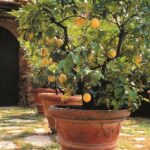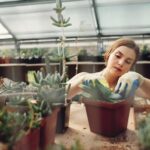Container gardening vegetables ideas offer a practical and versatile solution for individuals with limited outdoor space or those looking to add a touch of greenery to their homes. This method of growing vegetables in containers has gained popularity due to its accessibility, flexibility, and potential for bountiful harvests. From apartment balconies to small patios, container gardening allows individuals to cultivate fresh produce without the need for a traditional garden plot.
Container gardening is an approach to growing fruits, flowers, and vegetables in containers rather than planting them directly into the ground. This method is ideal for urban dwellers, renters, or anyone looking to maximize space while reaping the benefits of homegrown produce. With the right techniques, materials, and creativity, it is possible to cultivate a thriving vegetable garden in containers of various shapes and sizes.
In this article, we will explore the numerous benefits of container gardening for vegetables, discuss essential factors to consider when choosing containers for vegetables, highlight some of the best vegetable options for container gardening, and provide tips on watering, fertilizing, and maintaining a healthy container garden. Whether you are new to gardening or an experienced gardener seeking fresh ideas, this guide will equip you with valuable insights and inspiration for your container gardening journey.
Benefits of Growing Vegetables in Containers
Container gardening offers numerous benefits for individuals looking to grow their own vegetables, even if they don’t have access to a traditional garden space. One major benefit is the ability to control the growing environment, which can lead to higher success rates and healthier plants. Additionally, container gardening allows for greater flexibility in terms of placement, making it accessible to urban dwellers or those with limited outdoor space.
Increased Accessibility and Convenience
One of the main advantages of container gardening is its accessibility. Individuals with physical limitations or those who may not have access to traditional gardening plots can still enjoy the benefits of growing their own vegetables. Containers can be placed on a patio, balcony, or even indoors, providing convenience and easy access for tending and harvesting crops.
Pest and Disease Control
Container gardening also offers better control over pests and diseases that commonly affect vegetable plants. By growing vegetables in containers, gardeners can minimize the risk of soil-borne illnesses and may be able to isolate affected plants more easily if an issue arises. This level of control contributes to healthier plants overall.
Extended Growing Season
Another advantage of growing vegetables in containers is the ability to extend the growing season. Containers can be moved indoors during colder weather or positioned in areas that receive optimal sunlight throughout different times of the year. This flexibility allows for a longer harvest period and the potential for continuous production of fresh vegetables.
Choosing the Right Container for Vegetable Gardening
When it comes to choosing the right containers for your vegetable garden, there are a few key considerations to keep in mind. First, you’ll want to select a container that is large enough to accommodate the root systems of the vegetables you plan to grow. For most vegetables, a container that is at least 12 inches deep and 12 inches in diameter should suffice.
In addition to size, drainage is also an important factor to consider when choosing containers for vegetable gardening. Proper drainage is essential for healthy plant growth, so be sure to select containers with drainage holes in the bottom. If your chosen container does not have drainage holes, you can always drill or punch some yourself.
Another consideration when choosing containers for vegetable gardening is material. While plastic and terracotta are popular choices, there are a wide variety of materials available, each with its own advantages and disadvantages. Ultimately, the best material for your container will depend on factors such as climate, aesthetics, and personal preference.
Finally, consider mobility when choosing containers for your vegetable garden. Depending on the layout of your outdoor space, you may want to opt for containers with wheels or handles that make them easier to move around as needed.
| Consideration | Details |
|---|---|
| Size | At least 12 inches deep and 12 inches in diameter |
| Drainage | Containers should have drainage holes in the bottom |
| Material | Plastic and terracotta are popular choices but other materials are also available |
| Mobility | Select containers with wheels or handles suitable for movement |
Best Vegetables for Container Gardening
When it comes to container gardening vegetables ideas, there are many options to choose from. Here are some of the best vegetables that thrive in containers, making them perfect for your urban or small-space garden:
- Tomatoes: Tomatoes are one of the most popular vegetables for container gardening. They come in a variety of sizes and colors, and there are plenty of determinate or dwarf varieties that work well in containers.
- Peppers: Peppers, whether they’re sweet bell peppers or spicy jalapenos, also do well in containers. They can add some color and flavor to your vegetable garden.
- Lettuce: Lettuce is a great option for container gardening, especially if you enjoy fresh salads. It’s easy to grow and doesn’t take up much space.
There are other great options as well, such as carrots, radishes, green onions, and herbs like basil and parsley. When choosing your vegetables for container gardening, consider the space you have available and the amount of sunlight your containers will receive.
It’s important to remember that not all vegetables will thrive in containers, so it’s essential to choose the right ones for your specific gardening setup. With a little planning and creativity, you can have a successful container garden full of delicious and nutritious vegetables.
Container Gardening Techniques for Vegetables
Soil Preparation
When it comes to container gardening vegetables, the right soil mix is crucial for the success of your plants. It’s important to use a well-draining, lightweight potting mix that is specifically formulated for vegetable gardening. This will provide the necessary nutrients and aeration for the roots to thrive. Avoid using regular garden soil as it can become compacted in containers and hinder plant growth.
Proper Placement and Sun Exposure
One of the key techniques for successful container vegetable gardening is ensuring that your plants receive adequate sunlight. Most vegetable plants need at least 6-8 hours of direct sunlight per day, so be sure to place your containers in a location that receives sufficient sun exposure. Additionally, proper placement can help protect your plants from strong winds or extreme temperatures, which can impact their growth and health.
Regular Maintenance and Care
Container gardening vegetables require consistent maintenance and care to ensure healthy and productive plants. This includes regular watering to keep the soil evenly moist (but not waterlogged), monitoring for pests and diseases, and providing support for vining or tall-growing vegetables like tomatoes or pole beans. In addition, routine fertilizing with a balanced fertilizer can help replenish the nutrients in the soil and promote strong, vigorous growth in your vegetable crops.
By employing these container gardening techniques for vegetables, you can maximize the success of your container garden and enjoy a bountiful harvest of fresh, homegrown produce throughout the growing season. With proper preparation, maintenance, and care, even novice gardeners can experience the joys of growing their own vegetables in containers.
Tips for Watering and Fertilizing Container Vegetables
Watering and fertilizing container vegetables is crucial to ensure a healthy and bountiful harvest. Container gardening vegetables ideas can provide a lot of insight into the best practices for maintaining your vegetable garden. Here are some tips to help you achieve success with watering and fertilizing your container vegetables.
When it comes to watering container vegetables, it’s important to keep in mind that containers tend to dry out more quickly than traditional garden beds. It’s essential to check the moisture level of the soil regularly, especially during hot and dry weather.
To prevent waterlogged soil, which can lead to root rot, ensure that your containers have adequate drainage holes. Additionally, consider using a self-watering system or incorporating water-retaining crystals into the soil to help maintain consistent moisture levels.
Fertilizing container vegetables is also key to their overall health and productivity. Since nutrients can quickly leach out of container soils, regular feeding is necessary. Choose a high-quality, balanced fertilizer specifically formulated for vegetables and follow the recommended application rates on the package.
Consider using organic fertilizers for a more sustainable approach. Additionally, utilize slow-release fertilizers or liquid seaweed extracts to provide a steady supply of nutrients throughout the growing season. By paying close attention to the watering and fertilizing needs of your container vegetables, you’ll be well on your way to a successful harvest.
Remember that proper watering and fertilizing techniques are essential components of maintaining a thriving container vegetable garden. By following these tips, you can ensure that your plants receive the care they need to flourish and produce an abundance of delicious homegrown veggies.
Creative Container Ideas for Vegetable Gardening
Container gardening vegetables ideas can be as creative as your imagination allows. There are countless ways to repurpose everyday items and transform them into unique and functional containers for your vegetable garden. Here are some creative container ideas to inspire you:
- Use old wooden crates or pallets to create a rustic and charming look for your vegetable garden.
- Upcycle old tires by painting them in bright colors and stacking them to create tiered planters for your vegetables.
- Repurpose mason jars, tin cans, or old teapots as small containers for growing herbs or small vegetables like cherry tomatoes.
- Create a vertical garden using shoe organizers, PVC pipes, or even an old ladder to maximize space and grow more vegetables in a small area.
You can also get creative with the materials you use for your containers. Consider using unconventional items like wine barrels, laundry baskets, or even children’s wading pools as containers for your vegetable garden. The key is to ensure that the container provides adequate drainage and enough space for the roots of the vegetables to grow.
In addition to repurposing items around your home, you can also explore different types of traditional containers such as terracotta pots, hanging baskets, window boxes, or fabric grow bags. These options come in various sizes, shapes, and materials, allowing you to mix and match to create an eclectic and visually appealing vegetable garden on your patio or balcony.
Whether you have limited space or simply want to add a touch of creativity to your vegetable garden, exploring these container gardening vegetables ideas can help you cultivate a bountiful harvest while expressing your unique style through your garden design.
Common Container Gardening Mistakes to Avoid
When it comes to container gardening vegetables ideas, there are some common mistakes that many beginners make. These mistakes can hinder the growth and productivity of your vegetable plants. One of the most common mistakes is choosing the wrong size container for your vegetables. It’s important to select a container that is large enough for the root system of the plant, otherwise, your vegetables may become root-bound and stunted in their growth.
Another mistake to avoid is not providing adequate drainage for your containers. Without proper drainage, your vegetable plants can suffer from waterlogged soil, which can lead to root rot and other issues. Additionally, using the wrong type of soil can also be a common mistake. It’s crucial to use a high-quality potting mix that is specifically formulated for container gardening.
Overcrowding your containers is another common mistake that many beginner gardeners make. It’s important to give your vegetable plants enough space to grow and thrive. Overcrowding can lead to competition for nutrients and sunlight, resulting in poor growth and lower yields.
| Common Mistake | Effect |
|---|---|
| Choosing the wrong size container | Stunted growth and root-bound plants |
| Inadequate drainage | Waterlogged soil and root rot |
| Overcrowding containers | Poor growth and lower yields |
Harvesting and Maintaining Your Container Garden
In conclusion, container gardening is a fantastic way to grow your own vegetables, even if you have limited space. With the right containers and techniques, you can enjoy a bountiful harvest of fresh produce right on your patio or balcony. Whether you’re a beginner or an experienced gardener, there are plenty of creative container gardening vegetables ideas to explore.
One of the key benefits of growing vegetables in containers is the ability to easily maintain and harvest your garden. With containers, you can control the soil quality and drainage, leading to healthier plants and higher yields. Harvesting your homegrown vegetables is incredibly rewarding, and maintaining your container garden allows you to continue enjoying fresh produce throughout the growing season.
When it comes to container gardening vegetables ideas, there are endless possibilities for creative and unique containers. From traditional pots and planters to repurposed items like crates or buckets, there are options to suit any style or space. By avoiding common mistakes such as overwatering or using the wrong size containers, you can ensure that your container garden thrives and produces an abundance of delicious vegetables for you to enjoy.
Overall, container gardening offers a convenient and enjoyable way to grow vegetables at home. With careful attention to choosing the right containers, selecting suitable vegetable varieties, and maintaining proper care techniques, anyone can experience success with their own container garden. So whether you’re new to gardening or looking for new ideas to revitalize your existing garden, consider exploring the world of container gardening for an abundant harvest of homegrown vegetables.
Frequently Asked Questions
What Are the Best Vegetables for Container Gardening?
The best vegetables for container gardening are those that don’t require a lot of space to grow, such as tomatoes, peppers, lettuce, and spinach. These types of veggies thrive in containers and can produce a good yield.
What Vegetables Grow Well Together in a Container?
Some vegetables that grow well together in a container include tomatoes, basil, and onions. These three complement each other’s growth habits and also work well from a culinary perspective since they are often used together in cooking.
What Is the Best Food for Container Vegetables?
The best food for container vegetables is a balanced fertilizer specifically formulated for vegetable plants. Look for a fertilizer with equal or near-equal amounts of nitrogen, phosphorus, and potassium to support the overall growth and health of the plants in your containers.

Welcome to my gardening blog! I am passionate about plants and enjoy sharing my knowledge and experiences with others. In this blog, I will write about everything related to gardening, from tips on how to get started to updates on my own garden projects.





